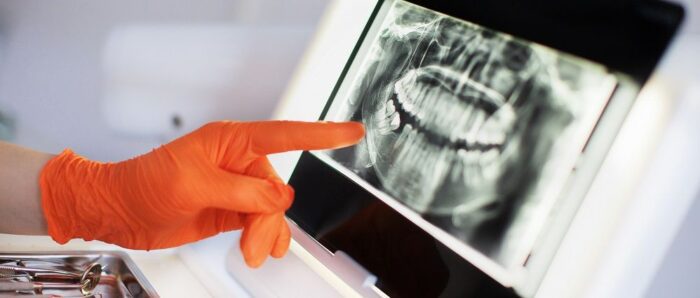When you attend a routine dental check-up, your dentist performs a visual exam of your smile. They check your teeth and gums for signs of any problems and they can offer swift treatment based on what they see. So why do dentists also recommend receiving routine x-rays of your smile?
Though a visual exam reveals a great deal about your oral health, a dentist will not see everything they need to with the naked eye. X-ray imaging can let a dentist know more about the internal well-being of your teeth and jaw. Read on to learn about three of the uses of routine dental x-rays.

What Will a Dental X-Ray Do?
Locate Hidden Tooth Decay
In many cases, a dentist can spot a cavity, an early form of tooth decay, on a tooth right away. Some patients present with pain in their teeth or dark discoloration where bacteria has eaten a hole into the dental structure. Then the dentist can treat the problem with a filling quickly.
But cavities do not always come with noticeable symptoms. And they may also form in hard-to-see places like between teeth. Cavities will show up clearly on a dental x-ray though.
With this imaging in conjunction with the rest of your routine dental care, you can receive urgent treatment for this dental concern. Then you do not have to worry about lasting damage caused by advanced tooth decay.
Evaluate Tooth Pulp Health
Even if you cannot see external symptoms, the interior of your tooth might sustain damage that requires dental attention. Your tooth pulp features blood vessels that could become blocked or restricted, leaving your teeth vulnerable to many dental dangers.
Sometimes tooth pulp damage comes with noticeable pain or discoloration, but your dentist can also spot signs of these issues on a dental x-ray. If a dentist can diagnose a problem with your tooth pulp, they will be able to provide better preventative care to protect your smile from further harm.
Dentists suggest getting these routine dental x-rays once a year. They are perfectly safe for patients of all ages.
Monitor Tooth Growth
By adolescence age, most dental patients lose their baby teeth and have their adult teeth grown into place. But teeth might shift out of position for a number of reasons, putting you in danger of oral health complications. A dentist can keep an eye on your dental alignment with x-ray imaging. Then they can intervene to keep your smile straight where needed.
Many people have other teeth that might grow after puberty: wisdom teeth. These extra molars often create problems for your other teeth as they grow, so a dentist will want to keep an eye on them and offer treatment if necessary.
A dentist can extract wisdom teeth before they become impacted or harm your teeth and gums if they see potential issues on a dental x-ray. Find expert preventative care like this by calling your dentist today.
